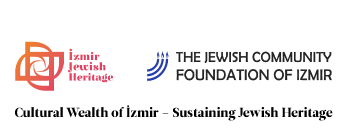Izmir's Jewish Community Old Books Collection
The total number of these books is approximately 2,730.
Year of Publication
The earliest book dates to 1654 (5414).
“Shoshanim le’David” (The book of Roses of David) – commentary on the Mishna.
Author: David Fardo.
Printed in Padova & Verona.
The latest books: from mid-20th century (mostly small-sized calendars) and ten sets of brand new Bibles and New Testaments.
- Most of the books were printed between the years 1750-1850.
The oldest books that were printed in Izmir are from the 18th century.
“Sefer Knesset Hagdola” (the Book of the Great Assembly).
Year of printing: 1724.
Author: Hayim Benvenisti.
“Yad Aharon” (Aharon’s Memorial).
Year of printing: 1756
Author: Aharon Moshe Alphandari
The oldest book that was printed in Jerusalem is from the year 1843: “Shem Hadash” (New Name).
Author: Shmuel Rachamim Pinso.
The printer: Israel Bak. (Bak founded the first printing press in the land of Israel. Following an earthquake in the northern town of Safet at the end of the 1830’s, bak moved to Jerusalem and founded the first print shop in the city).
Language
Most books are written in Hebrew, sometimes mixed with Aramaic, printed either in Rashi script or square Hebrew letters.
A small part of the collection is of Ladino books, also printed in Hebrew letters or Rashi script, and newer ones in Latin letters.
Typical Contents of The Books
Hebrew books:
- Bibles, some of them translated to Ladino, and one Bible printed in
- “Mishna” (Oral Torah)
- Babylonian
- “Arba’a Turim” (Four Columns).
- Halachic scripts deciphering the “Mishna”, Babylonian and Jerusalem Talmud, HaTurim commentary, Maimonides,
- Jewish mysticism, such as “Zohar”,ljk “Idra zuta”,
- “Musar” literature (ethics and moral books) and few philosophy
- Responsa to Halachic
- “Midrash” (folklore literary commentary to the Bible).
- “Drash” (weekly commentary on the Torah that was said orally in synagogues).
- “Tehilim” (Psalms). Some are booklets with only a few
- Guides to learning Hebrew letters and
- Small formats of “Hallel Hagadol” (a festive prayer).
- Ten sets of Bibles with New Testament (completely new).
Ladino books:
A few religious books in Ladino:
- Abbreviated
- “Zohar” translation into Ladino, printed in
Part of the collection includes approximately 30 Ladino books on secular subjects:
- Reading books translated from French and German dating to the 19th
- History books on the Ottoman Empire and on Jewish History dating to early 20th
- Calendar booklets dating to the 20th
- Hebrew grammar
Places of Printing
Izmir, Istanbul, Ankara, Thessaloniki, Jerusalem. Bilgordo (Belgrade), Prague, Vienna, Berlin, Frankfurt, Zoltzbach, Livorno (Leghorn), Venice, Piorda, Amsterdam, Pressburg, Warsaw, Krakow, Vilna, Basdiliav, Monkatch, Brin, Slavitta, Lick.
The books were brought from other cities in the Ottoman Empire and from all across Christian Europe.
Recommendations (“Haskamot”)
Some of the books have recommendations from other rabbis from around the Ottoman Empire and Europe.
Common features of front pages in religious books
- Usually written in Hebrew.
- Name of book and sometimes its
- In some of the books the title includes the author’s name (Rabbi Haim Palaggi wrote the book “Haim Veshalom” – “Life and Peace”).
- Place of
- Name of the printer (sometimes accompanied by his graphic trademark; Photo 16 and 17).
- Year of printing, marked mostly by a biblical quote, where the bold letters mark the Hebrew
- Sometimes there are praises of the author and/or the donors who enabled the printing of the book, or dedications by the
- The name of the Sultan (in the Ottoman Empire) or the ruling king. This is accompanied by words of praise &
- Prologues and recommendations by other renowned rabbis (often from other cities).
- Most books of a Christian-European origin have an apologetic opening which clarifies that their non-Jewish neighbors are not the same people as the “Goyim” or “Akum” (pagans) who are bad-mouthed throughout the Jewish
- Some of the European books have a comment of approbation by the local authority in the local language (Photo 15).
- Many of the books have a decorated front page. It seems that the European books have fancier decorations, with pillars, plants, and human figures (such as Moses and Aharon, angels, etc.). Some of them have a two-color front page. In some of the Ottoman books we can identify a European influence on the front page design (Photos 18-20).
Several insights deriving from the study
In the collection we saw many books that were printed in Livorno. The historical research of Dr. Barnai shows that during the 17th century Jews named “Francos” (Jews of Portuguese origin) settled in the city. Barnai hypothesized that the “Francos” came from Livorno in Italy.
One of the families that immigrated to Izmir from Livorno was the Gabay family. In 1654 they founded the first Jewish print shop in Izmir – the Gabay print shop, which was moved from Livorno. Some of the books were printed in Izmir. The oldest found were printed in Izmir during the first half of the 18th century (in the 18th century religious books were also printed by Greek print shops).
List of Jewish printers in the city of Izmir
- Abraham Ben Yedidiah Gabbai (1654)
- Yona Ashkenazi (1724).
- Yaakov Balanci (1756).
- Yaakov and his brother, sons of Rabbi Shmuel Ashkenazi (1855).
- Ben Zion Binyamin Rodino (1860).
- Isaac Shmuel de Sigura (1868).
- Aharon Yehoshua de Sigura (1870).
- Avraham Pontremoli and Yaakov Poly (1876).
- Hayim Avraham (1889).
Most of the religious books were probably used in the Yeshivas and the Batei Midrash (study halls) of Izmir. On some of the covers of the books there appears the inscription: Yeshivat Beit Hillel. Some of the books from the Yeshiva date to the 18th century.

